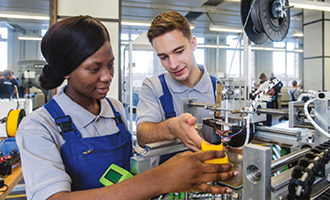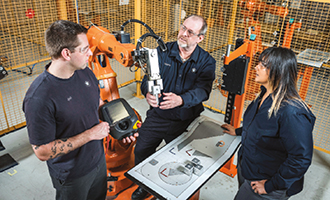Learning From Practice: How European Apprenticeships Impact the U.S.
August 01, 2018
A German researcher on how a time-tested model can be an alternative to the 'college for all' movement

In Germany, more than 500,000 young people each year start an apprenticeship in agriculture, industry, a trade or service field. Teachers encourage their students to participate in these apprenticeships during their final two years of high school,
giving first-hand work experience to teenagers who generally have no idea what goes on in the work world.
Apprenticeship opportunities abound in newspaper ads throughout Germany, and many chambers of commerce provide internet access
to companies that offer apprenticeships to teenage students. In contrast, the vocational culture in the United States appears to be more marginalized and fragmented. Apprenticeships in trade occupations such as carpentry dominate, while programs
in mechatronics or automotive professions are rare.
Apprenticeships open to high schoolers in Germany have been around for years, so it is not surprising that German industries with a presence in the U.S. are having an impact on the
growth of youth apprenticeships. Companies such as Siemens, Bosch and Mercedes Benz all have brought their apprenticeship programs across the pond and now offer opportunities for American students.
Mercedes Benz
The Mercedes Benz apprenticeship program is part of a partnership with Shelton State Community College in Tuscaloosa, Ala. Its popularity has surged, growing from 50 applicants at the start six years ago to more than 1,000 today. They are vying for roughly 40 apprenticeship positions with the car maker each year. After qualification, most of these apprentices transfer into long-term employment with the auto manufacturer.A shortage of skilled workers, the increasing quality demands of production and the level of skilled work required prompted Mercedes Benz to develop apprenticeships for students who are 18 and older in close cooperation with the 7,000-student, two-year community college. The intention was to transform the image of vocational training from a second-best option for losers to a first choice and a real alternative to academic studies in four-year degree programs that come with high fees and no certain job prospects at graduation. In Germany, the motivations for choosing an apprenticeship are similar.
The term “dual training” perfectly describes the idea behind every apprenticeship, as apprentices split their days between coursework at a community college (which in Germany is the home of vocational education and training) and work at a company that’s typically located in proximity to the college.
Every profession requires practical learning in a company setting. The theories that participants learn in college classes are reinforced by the practical work and by organized learning about assignments and business processes. The role of the college is to teach the basics underlying the work.
This is the model applied at Shelton State Community College. Trainers at Mercedes Benz communicate with the college’s professors. In weekly meetings, they coordinate the work and learning processes in both learning venues. Upon completion of the program, apprentices receive a certificate and college credit toward their degree. Many apprentices opt to continue with further training after they finish the program, hoping to obtain a full-time job upon graduation.
In Germany, this level of intense interaction between college and company is rare. There are various explanations for this. First, the college classes bring together apprentices from many more companies — sometimes as many as 15. There also is the problem of limited personnel at companies and paid teaching hours, as well as a lack of cooperation among companies.

PHOTO COURTESY OF SIEMENS AG, MUNICH, GERMANY
A leading training manager at a large German enterprise with more than 3,000 employees that offers more than 300 apprenticeships concedes the youth training is essential to the company’s operations. “If we didn’t provide apprenticeships in some occupations, we would have big problems finding enough young people ready to join our company,” says the training manager, who asked to withhold his name. An estimated 70-80 percent of apprentices remain with the company.
Based on his long-term experience, the German training manager recommends apprenticeships be developed more widely. “Employees trained in apprenticeships fit better into our enterprise,” he says. “They have a high level of commitment to the company and to their profession.”
Best Practices
When the Shelton program was launched in spring 2012, there was a shortage of skilled workers as the baby boomer generation began to retire and not enough young applicants were available to fill the gap. What’s more, Mercedes Benz needed to improve the skills of its workforce for the more complex systems in use today that require operators and mechanics to quickly understand and adapt to new technologies and know how to troubleshoot if problems arise.Successful and effective in-company training depends not only on what trainees learn but also on how they learn. Experience in Germany and the U.S. has shown that apprentices thrive when they:
» Receive clear instruction from an experienced worker, followed by the chance to work independently to gain personal experience. In this way, the apprentice learns to ask the right questions and work through different skill levels from beginner and advanced beginner to skilled worker.
» Work in a team, which helps a worker understand best practice and the value of good communication.
» Receive explicit demonstration of how his or her work relates to the work of others in the company and to the company as a whole.
» Get a chance to visit and learn from different departments in the company by spending time in all work stations and departments relevant to completing a product. This gives the apprentices new perspectives so they can understand what factors come together to influence high-quality business and work processes.
German trainers say this is how they can analyze the specific qualities of individual apprentices, build on their strengths and assess their future potential with the company. Similar processes apply at Mercedes Benz. Since 2012, 254 apprentices have successfully completed the company’s program; some are now employed as automotive repair team members, production team leaders or project team members.
The program reveals the practical and performance potentials of apprentices, helping employers identify the right person for the right job and giving the apprentice a long-term role within production.

PHOTO COURTESY OF BMW MANUFACTURING CO. LLC, GREER, S.C.
The German Model
What does the dual model mean for colleges? The newly recruited classroom faculty at Shelton State Community College have industrial and engineering backgrounds and have adapted their teaching methods to reflect more closely what and how apprentices learn at work.The particular approach in Germany and at Bremen’s vocational education and training school, Technisches Bildungszentrum, or TBZ, is that teachers follow a curriculum for each profession, but also maintain a close dialogue with the training company.
TBZ Director Joerg Metag explains how the partners cooperate: “We have to understand the company’s business and work processes as fully as possible,” he says. “Basic knowledge is combined with applied knowledge and skills developed on the job. Our vocational teachers are technical professionals with experience in industry. They know exactly what to teach.”
The teachers and the company trainers meet regularly to ensure close integration of the two areas of training. They also evaluate the professional performance of apprentices, and teachers visit the training enterprise to ensure what apprentices learn in their courses remains applicable to their work.
Metag says he supports the creation of cross-institutional projects that encourage teams of students from different departments to work together on a specific thematic technical problem, mimicking what they might face later in the working world.
The construction technology apprentice Tamerlev Gasteev, 19, works in a small trade company, Siever & Knueppel. Based in Bremen and with a workforce of 12, the company is managed by Dieter Siever. He is also Gasteev’s authorized trainer for his first year. Gasteev didn’t want to attend a university because he sees himself as a practical learner. He likes working at the company because he can see the results of his work immediately and is increasing his skills under the watchful eye of Siever and his colleagues.
“I have to work hard, not only in the company, but also at the VET (vocational education and training) school, for example, in courses on basic electrical circuits,” Gasteev says. “So my week is packed full and I don’t have much time for a social life, but I think it’s worth it. After passing my final exam, I can stay at S&K or look for a job in another company.”
Siever thinks good trainers are key to producing highly skilled apprentices. Based on his 25 years of experience as a trainer, he says “apprentices learn differently these days. What motivates them is working on real tasks in a company. Trainers have to put themselves in the apprentices’ shoes.”
A step-by-step approach is needed for the apprentice to progress from beginner to expert level. What’s crucial here are assessment points that show apprentices their pro-gress and success rate. Explanations should help them understand the interdependencies in the work process as well as the interplay between the tools and materials available.
Expanding Chances
As the success of European-style apprenticeships gains traction in the U.S., some native companies are taking notice. Dow Chemical Company, Ford and Microsoft currently offer apprenticeships, primarily to college students. More companies are likely to join, as the benefits include strengthening the labor market, increasing attention to quality and problem solving, and heightened commitment and loyalty to the company. The sharing of costs will allow more young people to enter these valuable programs.Ludger Deitmer suggests these informational sources, all accessible in English:
ARTICLES
» “Educational Transfer as Transformation: A Case Study About the Emergence and Implementation of Dual Apprenticeship Structures in a German Automotive Transplant in the United States” by Michael Gessler, in Vocation and Learning, March 2017
» “Vocational Education and Training in a Global Context,” Federal Institute for Vocational Education and Training,
» “Workforce Skills and Innovation: An Overview of Major Themes in the Literature” by Phillip Toner, OECD Education Working Paper series
WEBSITES
» European Centre for the Development of Vocational Training, individual country reports on apprenticeships in Europe, including Germany
» Institute Technology and Education, University of Bremen
» Shelton State Community College’s apprenticeship program
» Technical Vocational and Education School Center, Bremen, Germany
Advertisement
Advertisement
Advertisement
Advertisement


